air condition Lexus ES300h 2019 Owner's Manual (OM06178U)
[x] Cancel search | Manufacturer: LEXUS, Model Year: 2019, Model line: ES300h, Model: Lexus ES300h 2019Pages: 456, PDF Size: 9.59 MB
Page 1 of 456

1
2
3
4
5
6
7
8
9
Pictorial indexSearch by illustration
For safety and
securityMake sure to read through them
(Main topics: Child seat, theft deterrent system)
Vehicle status
information and
indicatorsReading driving-related information
(Main topics: Meters, multi-information display)
Before drivingOpening and closing the doors and windows,
adjustment before driving
(Main topics: Keys, doors, seats, power windows)
DrivingOperations and advice which are necessary for driving
(Main topics: Starting hybrid system, refueling)
Interior featuresUsage of the interior features
(Main topics: Air conditioner, storage features)
Maintenance and
careCaring for your vehicle and maintenance procedures
(Main topics: Interior and exterior, light bulbs)
When trouble
arisesWhat to do in case of malfunction and emergency
(Main topics: Battery discharge, flat tire)
Vehicle
specificationsVehicle specifications, customizable features
(Main topics: Fuel, oil, tire inflation pressure)
For ownersReporting safety defects for U.S. owners, and seat belt,
SRS airbag and headlight aim instructions for Canadian
owners
IndexSearch by symptom
Search alphabetically
Page 3 of 456
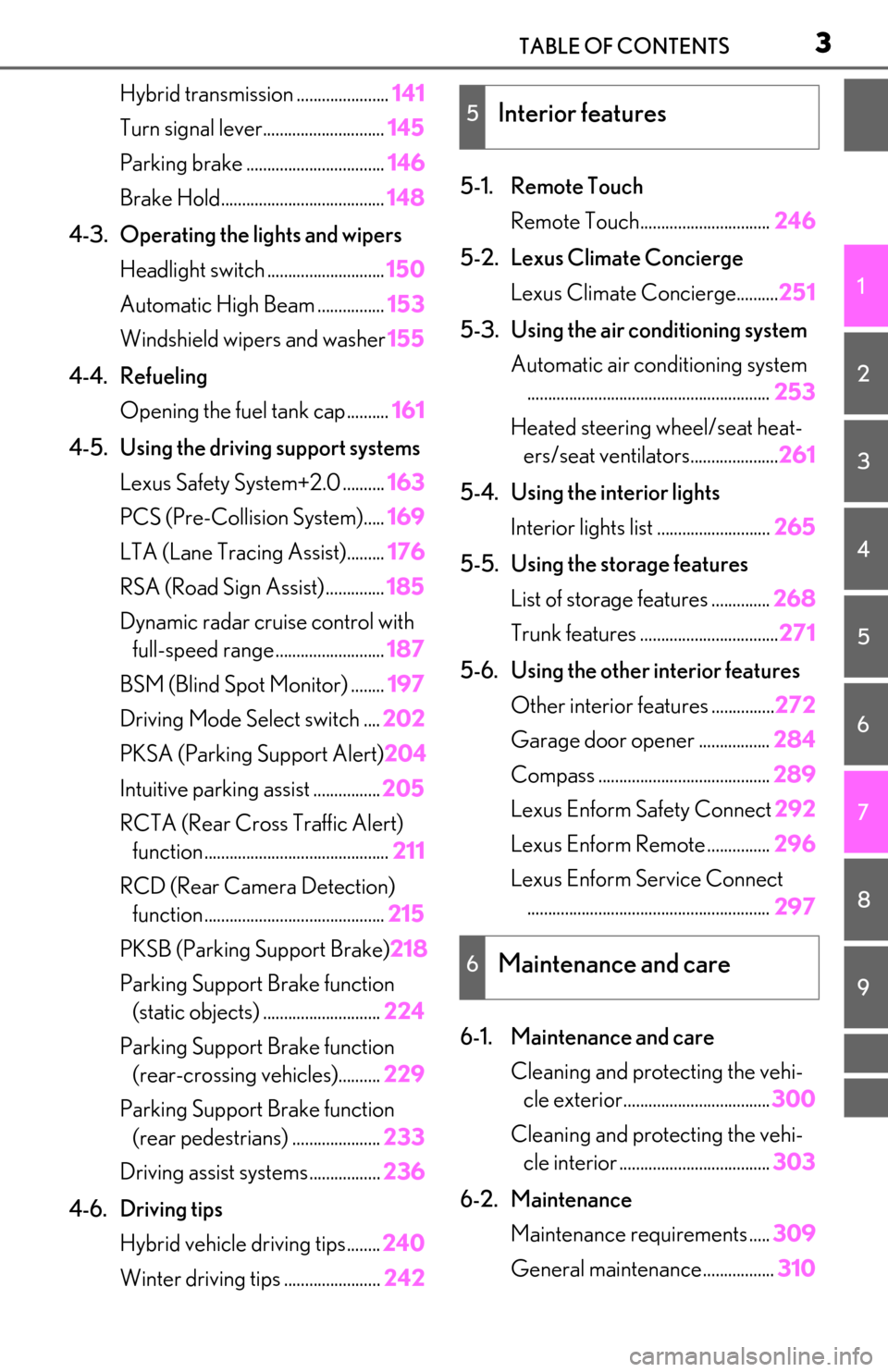
3TABLE OF CONTENTS
1
2
3
4
5
6
7
8
9
Hybrid transmission ......................141
Turn signal lever............................. 145
Parking brake ................................. 146
Brake Hold....................................... 148
4-3. Operating the lights and wipers Headlight switch ............................ 150
Automatic High Beam ................ 153
Windshield wipers and washer 155
4-4. Refueling Opening the fuel tank cap.......... 161
4-5. Using the driving support systems Lexus Safety System+2.0 .......... 163
PCS (Pre-Collision System)..... 169
LTA (Lane Tracing Assist)......... 176
RSA (Road Sign Assist) .............. 185
Dynamic radar crui se control with
full-speed range.......................... 187
BSM (Blind Spot Monitor) ........ 197
Driving Mode Select switch .... 202
PKSA (Parking Support Alert) 204
Intuitive parking assist ................ 205
RCTA (Rear Cross Traffic Alert) function ............................................ 211
RCD (Rear Camera Detection) function ........................................... 215
PKSB (Parking Support Brake) 218
Parking Support Brake function (static objects) ............................ 224
Parking Support Brake function (rear-crossing vehicles).......... 229
Parking Support Brake function (rear pedestrians) ..................... 233
Driving assist systems ................. 236
4-6. Driving tips Hybrid vehicle driving tips........ 240
Winter driving tips ....................... 2425-1. Remote Touch
Remote Touch............................... 246
5-2. Lexus Climate Concierge Lexus Climate Concierge.......... 251
5-3. Using the air conditioning system Automatic air conditioning system.......................................................... 253
Heated steering wheel/seat heat- ers/seat ventilators..................... 261
5-4. Using the interior lights Interior lights list ........................... 265
5-5. Using the storage features List of storage features .............. 268
Trunk features ................................. 271
5-6. Using the other interior features Other interior features ............... 272
Garage door opener ................. 284
Compass ......................................... 289
Lexus Enform Safety Connect 292
Lexus Enform Remote ............... 296
Lexus Enform Service Connect .......................................................... 297
6-1. Maintenance and care Cleaning and protecting the vehi-cle exterior................................... 300
Cleaning and protecting
the vehi-
cle interior .................................... 303
6-2. Maintenance Maintenance re quirements .....309
General maintenance................. 310
5Interior features
6Maintenance and care
Page 4 of 456
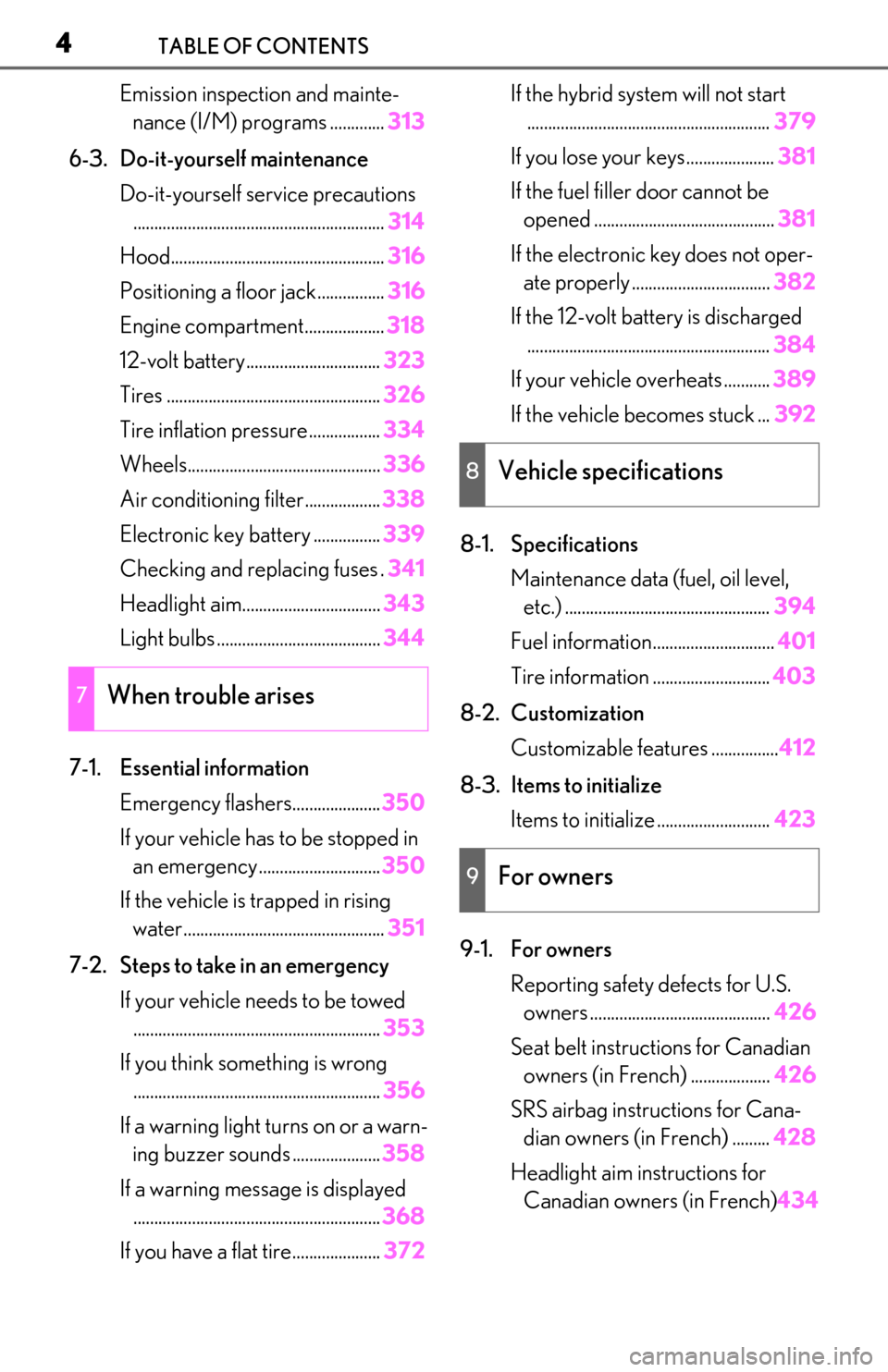
4TABLE OF CONTENTS
Emission inspection and mainte-nance (I/M) programs ............. 313
6-3. Do-it-yourself maintenance Do-it-yourself service precautions............................................................ 314
Hood................................................... 316
Positioning a floor jack................ 316
Engine compartment................... 318
12-volt battery................................ 323
Tires ................................................... 326
Tire inflation pressure ................. 334
Wheels.............................................. 336
Air conditioning filter..................338
Electronic key battery ................ 339
Checking and replacing fuses . 341
Headlight aim................................. 343
Light bulbs ....................................... 344
7-1. Essential information Emergency flashers..................... 350
If your vehicle has to be stopped in an emergency ............................. 350
If the vehicle is trapped in rising water................................................ 351
7-2. Steps to take in an emergency If your vehicle needs to be towed........................................................... 353
If you think something is wrong ........................................................... 356
If a warning light turns on or a warn- ing buzzer sounds ..................... 358
If a warning message is displayed ........................................................... 368
If you have a flat tire..................... 372If the hybrid syst
em will not start
.......................................................... 379
If you lose your keys..................... 381
If the fuel filler door cannot be opened ........................................... 381
If the electronic key does not oper- ate properly ................................. 382
If the 12-volt battery is discharged .......................................................... 384
If your vehicle overheats ........... 389
If the vehicle becomes stuck ... 392
8-1. Specifications Maintenance data (fuel, oil level, etc.) ................................................. 394
Fuel information............................. 401
Tire information ............................ 403
8-2. Customization Customizable features ................ 412
8-3. Items to initialize Items to initialize ........................... 423
9-1. For owners Reporting safety defects for U.S. owners ........................................... 426
Seat belt instructions for Canadian owners (in French) ................... 426
SRS airbag instructions for Cana- dian owners (in French) ......... 428
Headlight aim instructions for Canadian owners (in French) 434
7When trouble arises
8Vehicle specifications
9For owners
Page 15 of 456

15Pictorial index
When the warning messages are displayed..........................................................P.368
Parking brake switch ............................................................................................. P.146
Applying/releasing ............................................................................................................P.146
Precautions against winter season ................... ......................................................... P.243
Warning buzzer/message............................................................................................P.368
Turn signal lever ...................................................................................................... P.145
Headlight switch......................................................................................................P.150
Headlights/parking lights/tail lights/daytime running lights ........................... P.150
Automatic High Beam ..................................................................................................... P.153
Windshield wiper and washer switch ................................................................ P.155
Usage.......................................................................................................................... ............ P.155
Adding washer fluid ......................................................................................................... P.3 22
Warning messages ..........................................................................................................P.368
Emergency flasher switch .................................................................................. P.350
Hood lock release lever ........................................................................................ P.316
Tilt and telescopic steering control swit ch/tilt and telescopic steering lock
release lever .............................................................................................................. P.11 5
Adjustment ..................................................................................................................... ........ P.115
Driving position memory
*1...............................................................................................P.110
Air conditioning system ...................................................................................... P.253
Usage..................................................................................................................................... P.253
Rear window defogger................................................................................................... P.254
Audio system
*2
Trunk opener main switch ..................................................................................... P.101
*1: If equipped
*2: Refer to “NAVIGATION AND MULTIMEDIA SYSTEM OWNER’S MANUAL”.
E
F
G
H
I
J
K
L
M
Page 30 of 456

301-1. For safe use
Driver’s seat belt buckle switch
Airbag sensor assembly
“AIR BAG ON” and “AIR BAG OFF” indicator lights
Front passenger’s seat belt buckle switch
Front impact sensors
Your vehicle is equipped with ADVANCED AIRBAGS designed based on the US
motor vehicle safety standards (FMVSS208). The airbag sensor assembly (ECU)
controls airbag deployment based on information obtained from the sensors etc.
shown in the system components diagram above. This information includes crash
severity and occupant information. As the airbags deploy, a chemical reaction in
the inflators quickly fills the airbags with no n-toxic gas to help restrain the motion of
the occupants.
■If the SRS airbags deploy (inflate)
●Slight abrasions, burns, bruising etc., may
be sustained from SRS airbags, due to the
extremely high speed deployment (infla-
tion) by hot gases.
●A loud noise and white powder will be
emitted.
●Parts of the airbag module (steering
wheel hub, airbag cover and inflator) as
well as the front seat s, parts of the front
and rear pillars, and r oof side rails may be
hot for several minutes. The airbag itself
may also be hot.
●The windshield may crack.
●The interior lights will turn on automati-
cally. ( P.265)
●The emergency flashers will turn on auto-
matically. ( P.350)
●For Lexus Enform Safety Connect sub-
scribers, if any of the following situations
occur, the system is designed to send an
emergency call to the response center,
notifying them of the vehicle’s location
(without needing to push the “SOS” but-
ton) and an agent will attempt to speak
with the occupants to ascertain the level
of emergency and assi stance required. If
the occupants are unable to communi-
cate, the agent automatically treats the
call as an emergency and helps to dis-
patch the necessary emergency ser- vices.(
P.292)
• An SRS airbag is deployed.
• A seat belt pretensioner is activated.
• The vehicle is involved in a severe rear- end collision.
■SRS airbag deployment conditions (SRS
front airbags)
●The SRS front airbags will deploy in the
event of an impact that exceeds the set
threshold level (the level of force corre-
sponding to an approximately 12 - 18
mph [20 - 30 km/h] frontal collision with
a fixed wall that does not move or
deform).
However, this threshold velocity will be
considerably higher in the following situa-
tions:
• If the vehicle strikes an object, such as a parked vehicle or sign pole, which can
move or deform on impact
• If the vehicle is involved in an underride collision, such as a collision in which the
front of the vehicle underrides, or goes
under, the bed of a truck
●Depending on the type of collision, it is
possible that only th e seat belt preten-
sioners and SRS knee airbags will acti-
vate.
●The SRS front airbags for the front pas-
senger will not activate if there is no pas-
senger sitting in the front passenger seat.
However, the SRS front airbags for the
front passenger may deploy if luggage is
N
O
P
Q
R
Page 31 of 456
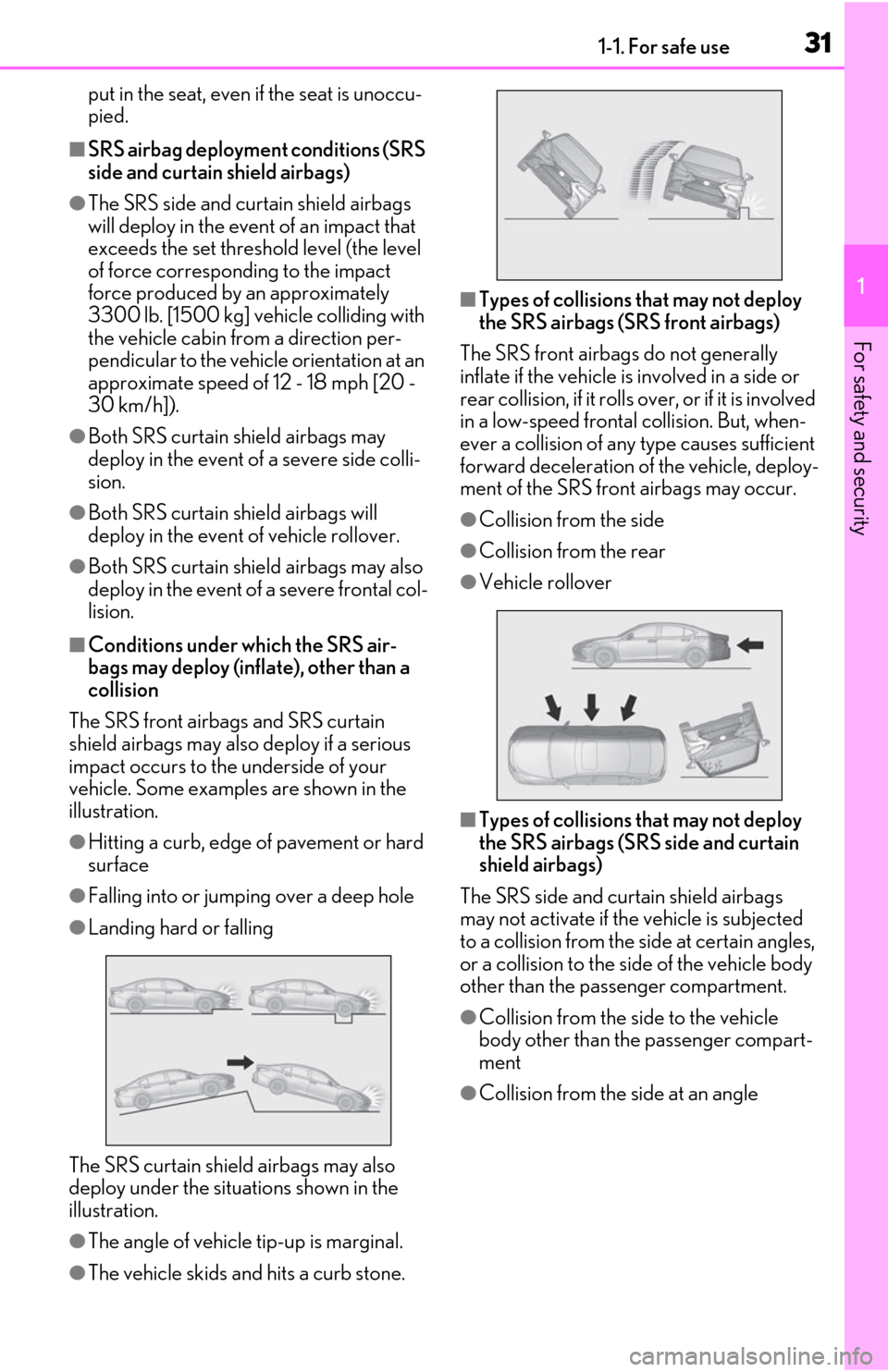
311-1. For safe use
1
For safety and security
put in the seat, even if the seat is unoccu-
pied.
■SRS airbag deployment conditions (SRS
side and curtain shield airbags)
●The SRS side and curtain shield airbags
will deploy in the event of an impact that
exceeds the set thresh old level (the level
of force corresponding to the impact
force produced by an approximately
3300 lb. [1500 kg] vehicle colliding with
the vehicle cabin from a direction per-
pendicular to the vehi cle orientation at an
approximate speed of 12 - 18 mph [20 -
30 km/h]).
●Both SRS curtain shield airbags may
deploy in the event of a severe side colli-
sion.
●Both SRS curtain shield airbags will
deploy in the event of vehicle rollover.
●Both SRS curtain shield airbags may also
deploy in the event of a severe frontal col-
lision.
■Conditions under which the SRS air-
bags may deploy (inf late), other than a
collision
The SRS front airbags and SRS curtain
shield airbags may also deploy if a serious
impact occurs to the underside of your
vehicle. Some examples are shown in the
illustration.
●Hitting a curb, edge of pavement or hard
surface
●Falling into or jumping over a deep hole
●Landing hard or falling
The SRS curtain shield airbags may also
deploy under the situations shown in the
illustration.
●The angle of vehicle tip-up is marginal.
●The vehicle skids and hits a curb stone.
■Types of collisions that may not deploy
the SRS airbags (SRS front airbags)
The SRS front airbags do not generally
inflate if the vehicle is involved in a side or
rear collision, if it rolls over, or if it is involved
in a low-speed frontal collision. But, when-
ever a collision of any type causes sufficient
forward deceleration of the vehicle, deploy-
ment of the SRS fron t airbags may occur.
●Collision from the side
●Collision from the rear
●Vehicle rollover
■Types of collisions that may not deploy
the SRS airbags (SRS side and curtain
shield airbags)
The SRS side and curtain shield airbags
may not activate if the vehicle is subjected
to a collision from the side at certain angles,
or a collision to the side of the vehicle body
other than the passenger compartment.
●Collision from the side to the vehicle
body other than the passenger compart-
ment
●Collision from the side at an angle
Page 37 of 456
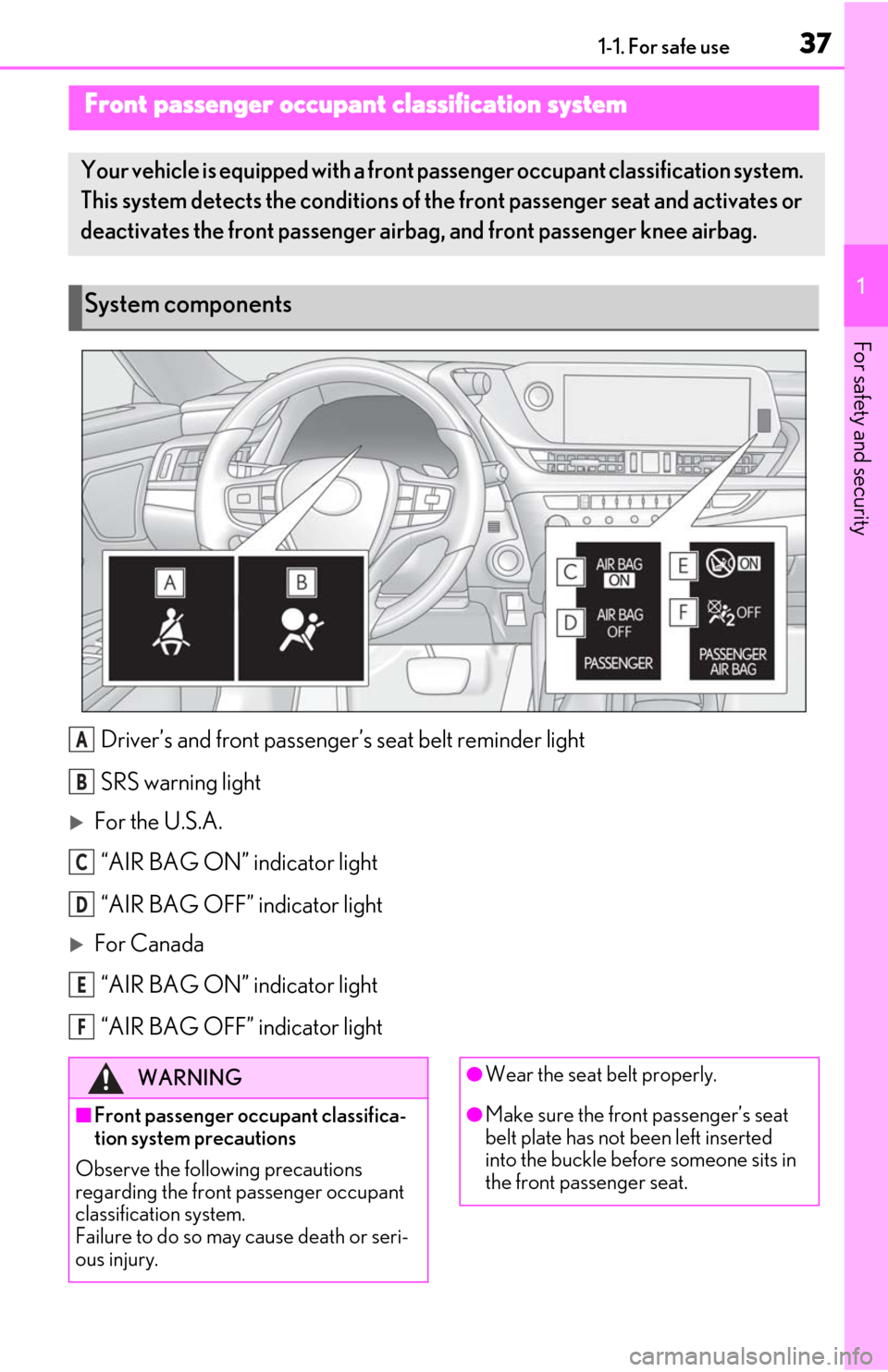
371-1. For safe use
1
For safety and security
Driver’s and front passenger’s seat belt reminder light
SRS warning light
For the U.S.A.“AIR BAG ON” indicator light
“AIR BAG OFF” indicator light
For Canada“AIR BAG ON” indicator light
“AIR BAG OFF” indicator light
Front passenger occupant classification system
Your vehicle is equipped with a front passenger occupant clas sification system.
This system detects the conditions of th e front passenger seat and activates or
deactivates the front passenger airbag , and front passenger knee airbag.
System components
A
B
C
D
E
F
WARNING
■Front passenger occupant classifica-
tion system precautions
Observe the following precautions
regarding the front passenger occupant
classification system.
Failure to do so may cause death or seri-
ous injury.
●Wear the seat belt properly.
●Make sure the front passenger’s seat
belt plate has not been left inserted
into the buckle before someone sits in
the front passenger seat.
Page 39 of 456
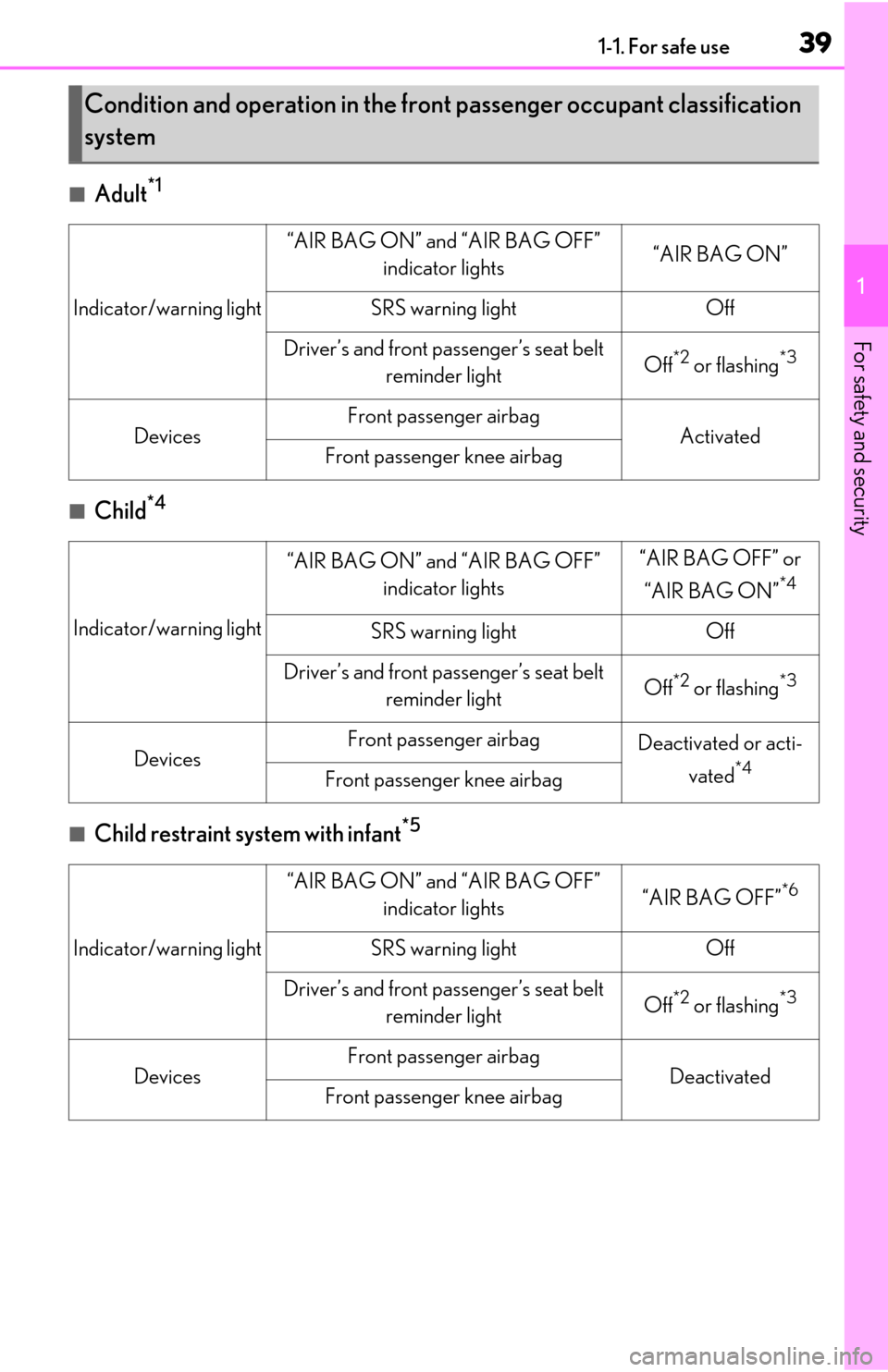
391-1. For safe use
1
For safety and security
■Adult*1
■Child*4
■Child restraint system with infant*5
Condition and operation in the front passenger occupant classification
system
Indicator/warning light
“AIR BAG ON” and “AIR BAG OFF” indicator lights“AIR BAG ON”
SRS warning lightOff
Driver’s and front passenger’s seat belt reminder lightOff*2 or flashing*3
DevicesFront passenger airbagActivatedFront passenger knee airbag
Indicator/warning light
“AIR BAG ON” and “AIR BAG OFF” indicator lights“AIR BAG OFF” or
“AIR BAG ON”
*4
SRS warning lightOff
Driver’s and front passenger’s seat belt reminder lightOff*2 or flashing*3
DevicesFront passenger airbagDeactivated or acti-
vated
*4Front passenger knee airbag
Indicator/warning light
“AIR BAG ON” and “AIR BAG OFF” indicator lights“AIR BAG OFF”*6
SRS warning lightOff
Driver’s and front passenger’s seat belt reminder lightOff*2 or flashing*3
DevicesFront passenger airbagDeactivatedFront passenger knee airbag
Page 56 of 456
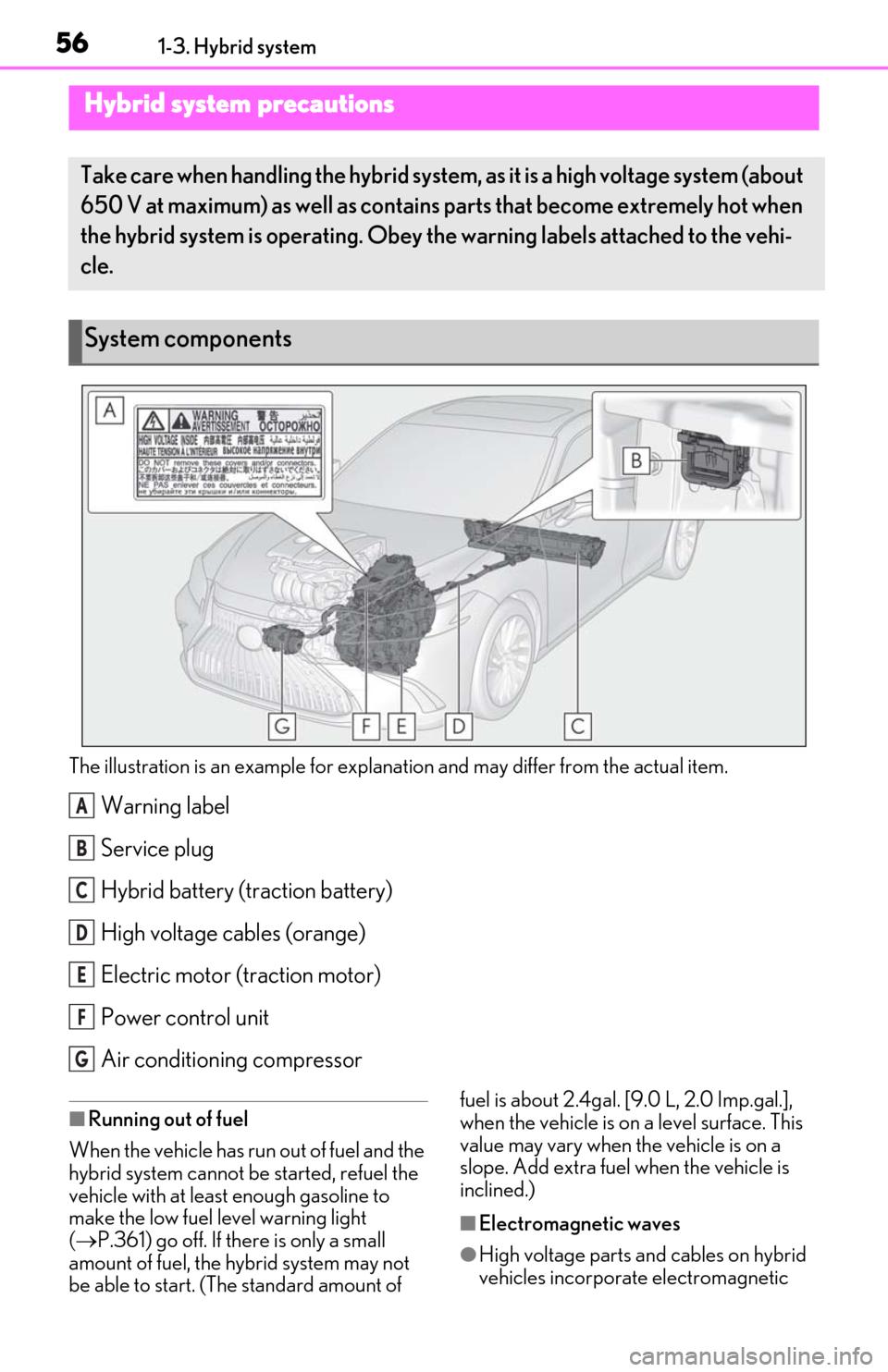
561-3. Hybrid system
The illustration is an example for explanation and may differ from the actual item.
Warning label
Service plug
Hybrid battery (traction battery)
High voltage cables (orange)
Electric motor (traction motor)
Power control unit
Air conditioning compressor
■Running out of fuel
When the vehicle has run out of fuel and the
hybrid system cannot be started, refuel the
vehicle with at least enough gasoline to
make the low fuel level warning light
( P.361) go off. If there is only a small
amount of fuel, the hybrid system may not
be able to start. (The standard amount of fuel is about 2.4gal. [9.0 L, 2.0 Imp.gal.],
when the vehicle is on a level surface. This
value may vary when the vehicle is on a
slope. Add extra fuel when the vehicle is
inclined.)
■Electromagnetic waves
●High voltage parts and cables on hybrid
vehicles incorporate electromagnetic
Hybrid system precautions
Take care when handling the hybrid system,
as it is a high voltage system (about
650 V at maximum) as well as contains parts that become extremely hot when
the hybrid system is operating. Obey th e warning labels attached to the vehi-
cle.
System components
A
B
C
D
E
F
G
Page 100 of 456
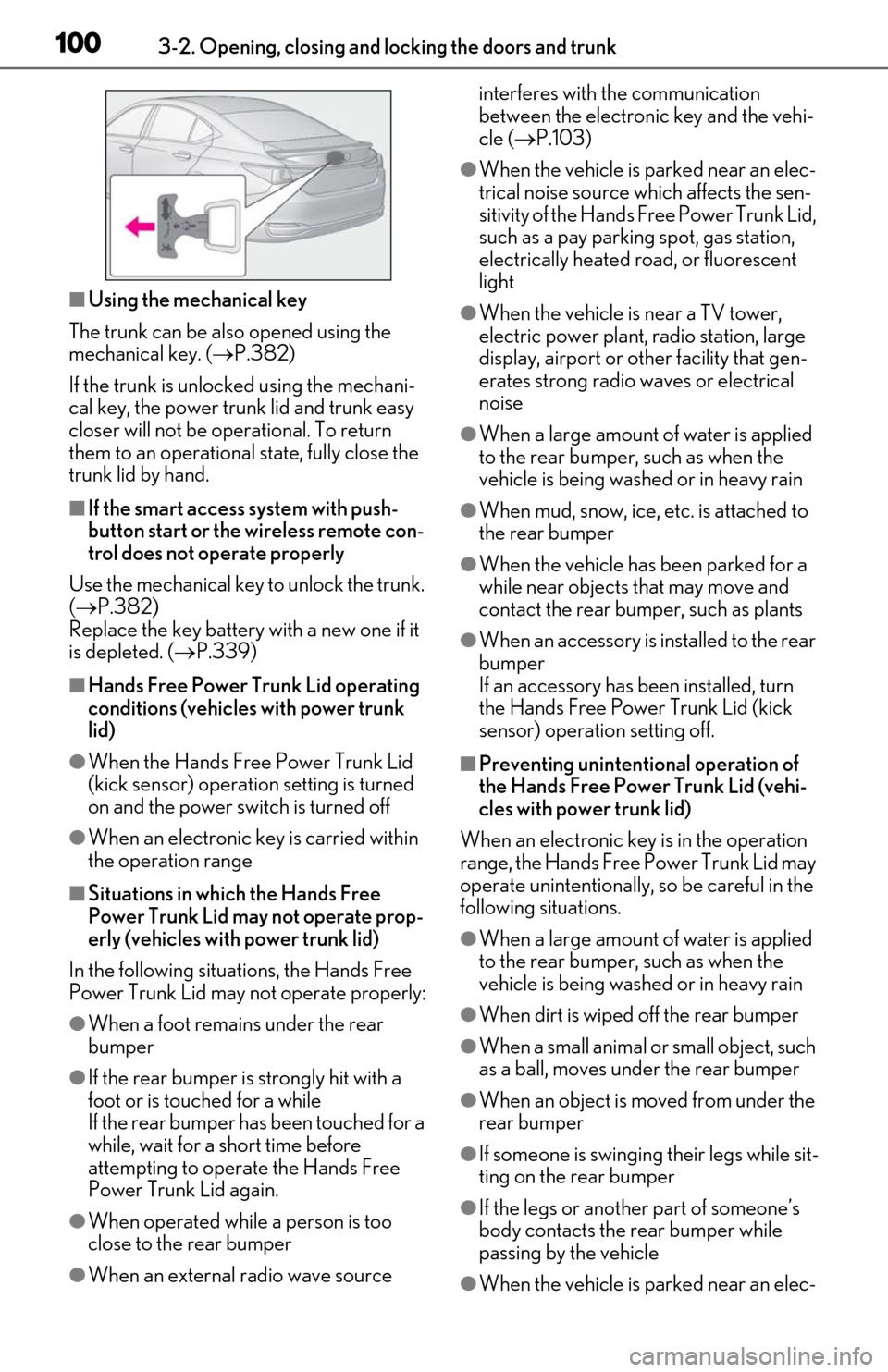
1003-2. Opening, closing and locking the doors and trunk
■Using the mechanical key
The trunk can be also opened using the
mechanical key. ( P.382)
If the trunk is unlocked using the mechani-
cal key, the power trunk lid and trunk easy
closer will not be operational. To return
them to an operational state, fully close the
trunk lid by hand.
■If the smart access system with push-
button start or the wireless remote con-
trol does not operate properly
Use the mechanical key to unlock the trunk.
( P.382)
Replace the key battery with a new one if it
is depleted. ( P.339)
■Hands Free Power Trunk Lid operating
conditions (vehicle s with power trunk
lid)
●When the Hands Free Power Trunk Lid
(kick sensor) operation setting is turned
on and the power switch is turned off
●When an electronic key is carried within
the operation range
■Situations in which the Hands Free
Power Trunk Lid may not operate prop-
erly (vehicles with power trunk lid)
In the following situations, the Hands Free
Power Trunk Lid may not operate properly:
●When a foot remain s under the rear
bumper
●If the rear bumper is strongly hit with a
foot or is touched for a while
If the rear bumper has been touched for a
while, wait for a short time before
attempting to operate the Hands Free
Power Trunk Lid again.
●When operated while a person is too
close to the rear bumper
●When an external radio wave source interferes with the communication
between the electronic key and the vehi-
cle (
P.103)
●When the vehicle is parked near an elec-
trical noise source which affects the sen-
sitivity of the Hands Free Power Trunk Lid,
such as a pay parking spot, gas station,
electrically heated road, or fluorescent
light
●When the vehicle is near a TV tower,
electric power plant, radio station, large
display, airport or ot her facility that gen-
erates strong radio waves or electrical
noise
●When a large amount of water is applied
to the rear bumper, such as when the
vehicle is being washed or in heavy rain
●When mud, snow, ice, etc. is attached to
the rear bumper
●When the vehicle has been parked for a
while near objects that may move and
contact the rear bumper, such as plants
●When an accessory is installed to the rear
bumper
If an accessory has been installed, turn
the Hands Free Power Trunk Lid (kick
sensor) operation setting off.
■Preventing unintentional operation of
the Hands Free Power Trunk Lid (vehi-
cles with power trunk lid)
When an electronic key is in the operation
range, the Hands Free Power Trunk Lid may
operate unintentionally, so be careful in the
following situations.
●When a large amount of water is applied
to the rear bumper, such as when the
vehicle is being washed or in heavy rain
●When dirt is wiped off the rear bumper
●When a small animal or small object, such
as a ball, moves under the rear bumper
●When an object is moved from under the
rear bumper
●If someone is swinging their legs while sit-
ting on the rear bumper
●If the legs or another part of someone’s
body contacts the rear bumper while
passing by the vehicle
●When the vehicle is parked near an elec-